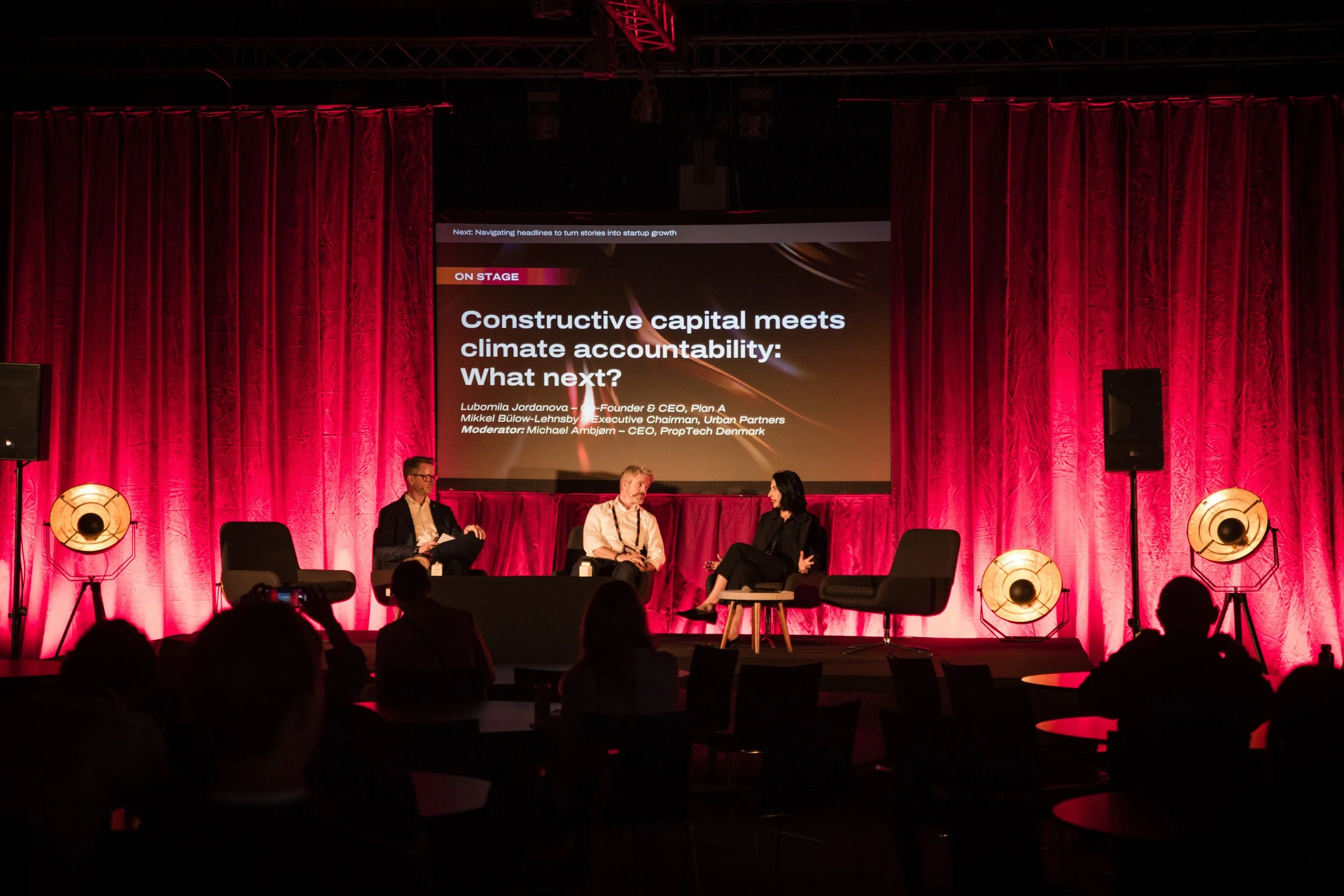The PropTech Guide to Water Management
Water. We can’t live without it when it’s in the right places, and we can’t live with it when it ends up in the wrong ones. Water has now firmly entered the conversation in reports, newspapers, magazines, cultural institutions – and around dining tables.
Michael Ambjørn
CEO, PropTech Denmark
Creative thinking around the impacts of water have even made it into the fictional space of popular culture, such as Thomas Vinterberg’s new drama series Families Like Ours on TV 2.
But let’s get back to reality: In a report by the think tank CONCITO, it’s estimated that, in Denmark, no fewer than 440,000 private homes, 120,000 commercial buildings, and 160,000 holiday homes are already at risk from extreme events like storm surges or intense rain. You can find this in the report linked in the sources below: The Impact of Climate Change on Future Land Use (consider including this in your next board meeting pack for reference).
What does this mean for the property sector now? Water is coming, and it’s coming from many directions: seawater, groundwater, rainwater, and water in the air as humidity. On top of that, water metrics must now be included in ESG accounts – there’s a lot to consider. Both innovative and digital approaches are needed. In the 2024 Danish PropTech Report, we learned that people are looking for much more data about their properties to strengthen their decision-making foundations. It’s not just the water levels rising; expectations for timely insights from data are increasing, too.
I reached out to several of our members, plus a few other knowledgeable minds, to explore some practical challenges and concrete solutions that can be implemented now. Think of it as an impromptu PropTech Guide to Water Management.
Water from the Outside and onto the Property
“A large number of buildings in Denmark are at risk of flooding, whether from storm surges, cloudbursts, or rivers overflowing. In most cases, collective solutions are needed – solutions that cross property boundaries and sometimes even municipal borders. But there are also many cases where relatively low-cost measures within the property can protect it from costly water damage,” says Sara Lerer, Head of Hydrology at Scalgo (and our neighbour at BLOXHUB), in our discussion. They have an interactive platform that easily reveals the overall risk picture and possible solutions for any property in the country.
What about prevention? The answer lies in planning and process, alongside any necessary physical changes to buildings and the use of sensors.
Pumps the Size of Buses
“Water always arrives inconveniently,” says Peter Hebin Bruun, Head of ESG at ATP Ejendomme, when I call to ask about water in commercial properties. This insight is worth integrating into an emergency response plan. While some buildings around Copenhagen Harbour are equipped with pumps as big as buses, equally important are so-called passive solutions – those that don’t require activation and just work when the water arrives. “Those who delay preparation will most likely be too late,” Peter notes, emphasising the need for timely action and strategic collaboration across properties. There’s also an ESG angle, which we’ll revisit later.
Data from Utility Providers
There’s a growing market of tech platforms capable of simulating various water scenarios across areas, enabling predictive maintenance on a large scale. In simpler terms, have you contacted your local utility provider and asked if they use solutions like Water Intelligence and Sewer Intelligence from specialists like InfoTiles? If not, what are they doing?
Focus on the Roof
Even the best passive solutions can sometimes fail. A roof may be one of the world’s oldest solutions for keeping water out, but Denmark has a large number of flat roofs, which often leads to significant damages that remain unnoticed for too long. Earlier this year, Tector (formerly Woodsense) secured €2 million from investors to target this market directly.
Construction sites are another area where water protection is needed. Copenhagen residents may have noticed a roof covering a construction site near the Maersk headquarters. This temporary production hall by Danish firm SiteCover, led by Jacob Maintz, is 8,280 square metres, preventing an average of 650 tons of water from reaching the site each month. This is crucial, as all construction covered by the Danish Building Regulations (BR18) must, under § 165, prevent moisture from being built into structures during construction.
Embedded Water and Sustainable Heating
Often, heat cannons are used after water damage has occurred. This is not only time-consuming but also affects both budgets and CO2 accounts. Instead, focus the heat on the tradespeople while they’re on-site. Acembee, this year’s UrbanTech Pitch winner at TechBBQ, led by Oline Stærke, provides on-demand heating solutions. Another useful type of “embedded water” is sprinklers, with Norwegian company FireMesh, led by Tahani Berge, offering a unique solution in this area.
Burst Pipes in Buildings
With large portfolios, keeping track can be challenging. Solutions like Smartvatten monitor over 20,000 buildings and 200,000 apartments across Northern Europe, detecting more than 50,000 cases of water damage annually. They use optical meters, though acoustic solutions are also available. Kamstrup offers a meter that uses sound for remote reading and boasts a lifespan of up to 16 years.
Are you a good neighbour?
Imagine your roof and building envelope are top-notch. How, then, do you become a good neighbour, considering the water you pass on? Your climate adaptation efforts could inadvertently contribute to your neighbour’s flooding. Here, there are two promising prototypes that temporarily absorb water. Rockwool’s prototype slows down water in specially designed drainpipes, and on Nørrebro in Copenhagen, you can explore a 50-metre pilot stretch of climate tiles. “This is a surface-level solution that reduces the need for deep excavation and can be quickly integrated with existing paving and water management systems,” explains Ole Schrøder, partner at Tredje Natur.
Sustainable Use of Clean Water
Finally, we should collectively consider how to use our clean water responsibly. Both FlowLoop and Orbital Systems focus on Circular Water, while Aguardio offers a bathroom-focused solution that helps to limit water use. For example, they note that 1 in 5 toilets has a leak, resulting in substantial water loss without anyone noticing.
Water in Reports: CSRD – Corporate Sustainability Reporting Directive
Water consumption now forms part of Scope 3 calculations (see Real ESG – The Real Estate Reporting Framework for priority categories). Or join PropTech Denmark’s Forum for Real Estate Data, where you and your peers explore this type of data and how to manage it effectively – without risking data overload. Also, consider the value of a visual overview; platforms like ViaMap offer strong capabilities here, even in water-related data management.
In summary: Water issues are making their way right into the boardroom. As Sead Bajrovic, formerly of Grundfos Ventures and now Managing Partner at Water Impact Partners, says: “It is crucial for the Danish property industry to prioritise water conservation and efficient water management. By investing in sustainable solutions, we can not only reduce costs but also protect property value and attract environmentally conscious (and risk-averse) tenants and investors.”
P.S. Climate Expedition, authored in part by Kirsten Halsnæs, professor at DTU, is an intriguing read. And if you’re visiting the highly relevant exhibition The Water is Coming at the DAC, you’ll be in the same building as our PropTech Lab & Investor Corner at BLOXHUB. Drop by for an espresso and a chat about the innovation needed in this area.
Editors note: An abbreviated version of this was previously printed in Danish in Børsen Ejendomme
Sources
CONCITO: The Impact of Climate Change on Future Land Use (Klimaforandringernes betydning for fremtidens arealanvendelse)
Kirsten Halsnæs et al.: Climate Expedition (Klimaekspeditionen)











